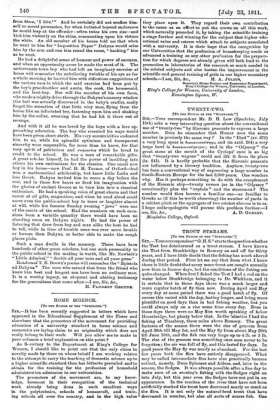TWENTY-TWO.
[To FHB EDITOR OF THB "SPECTATOR:1 Stn,—Your correspondent Mr. D. H. Low (Spectator, July 15th) asks a very interesting question about the conventional use of " twenty-two " by Slavonic peasants to express a large number. Does he remember that Homer uses the same number in precisely the same way ? In the "Iliad" (xv. 678) a very long spear is A -VOIKRIEHt0011r4Xu, and (in xxiii. 264) a very large bowl is BOWICCUELKOITI/AETpOt and in the "Odyssey" the great stone at the month of the Cyclops' cave is so big that "twenty-two wagons" could not lift it from its place (ix. 241). It is hardly probable that the Slavonia peasants are influenced by a literary tradition. Anyhow, twenty-two has been a conventional way of expressing a large number in South-Eastern Europe for the last 3,000 years. One wonders why. Has it perhaps something to do with the complement of the Homeric ship—twenty rowers (as in the " Odyssey " occasionally) plus the "captain" and the steersman P The number would thus become a familiar one—as familiar to Greeks as (if this be worth observing) the number of yards in a cricket pitch or the aggregate of two cricket elevens is to us. I hope anthropologists will pursue this problem further.—I






































 Previous page
Previous page